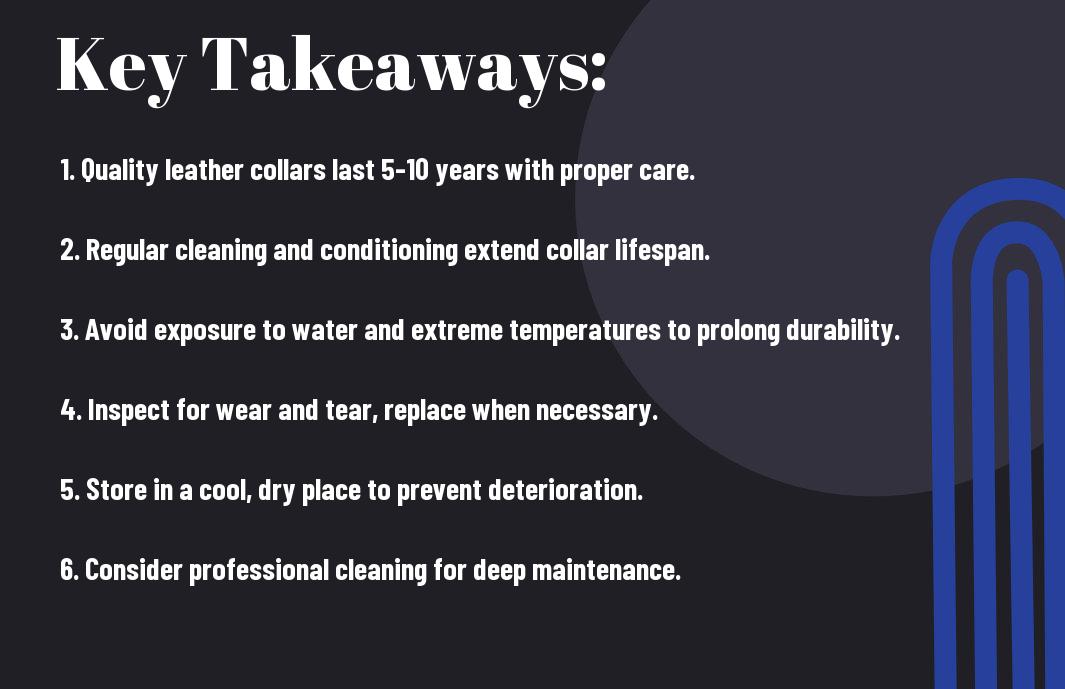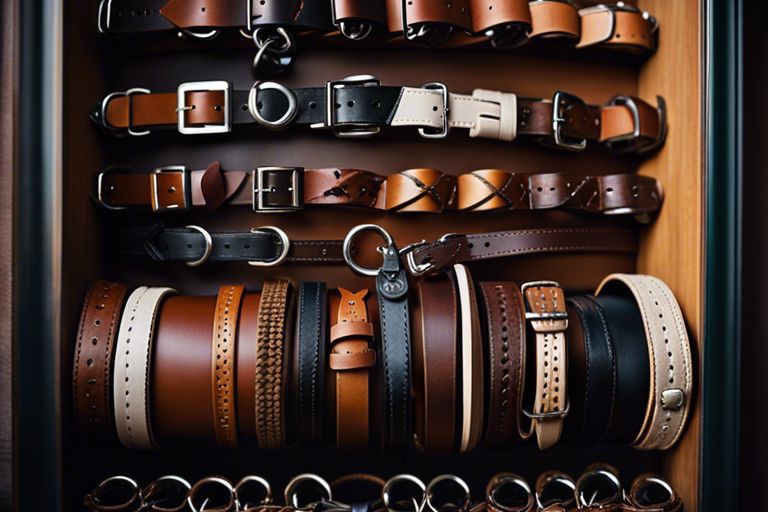Leather dog collars are a popular choice among pet owners for their durability and classic appeal. However, the lifespan of a leather collar can vary depending on various factors. In this informative post, we will probe into the key aspects that determine how long a leather collar can last, including quality, maintenance, and usage. Understanding these factors can help you make an informed decision when choosing a collar for your furry friend. For a deeper look into the comparison of leather collars with nylon ones, check out Comparing Leather Dog Collars with Nylon Ones – Xparkles.
Key Takeaways:
- Quality Matters: The durability of a leather collar largely depends on the quality of leather used.
- Proper Care: Regular cleaning and conditioning can extend the lifespan of a leather collar.
- Average Lifespan: A well-maintained leather collar can last anywhere from 2 to 5 years.
- Usage Frequency: How often the collar is worn and the activities the dog engages in can also affect its longevity.
- Safety First: Regularly check the collar for signs of wear and tear to ensure it remains safe for your pet to wear.

Factors Affecting the Lifespan of Leather Collars
Some factors play a crucial role in determining how long leather collars last. Understanding these factors can help pet owners make informed decisions when choosing a collar for their beloved companions.
- Quality of Leather
- Exposure to the Elements
- Proper Care and Maintenance
Quality of Leather
Leather quality is a primary determinant of how long a leather collar will last. High-quality leather, such as full-grain or top-grain leather, is more durable and resistant to wear and tear. Genuine leather collars are stronger and less likely to crack or break, ensuring they can withstand the daily activities of your pet.
Exposure to the Elements
On average, leather collars are durable and long-lasting, but their lifespan can be significantly impacted by exposure to the elements. It is imperative to protect your pet’s collar from moisture, sunlight, and extreme temperatures. Moisture can cause the leather to warp or mold, while sunlight and heat can dry out and crack the material. Extreme cold can also make the leather brittle and more prone to damage. Perceiving and minimizing exposure to these elements can help extend the life of your leather collar.

Maintenance and Care
Regular Cleaning and Conditioning
To ensure your leather collar lasts as long as possible, it is important to regularly clean and condition it. Use a damp cloth to wipe off any dirt or debris that may have accumulated on the collar. Apply a small amount of leather conditioner to keep the leather supple and prevent drying or cracking. This simple step can significantly extend the lifespan of your collar.
Proper Storage Practices
Proper storage of your leather collar is crucial to maintaining its quality. Store your collar in a cool, dry place away from direct sunlight to prevent fading and drying of the leather. Avoid storing it in plastic bags or containers, as this can trap moisture and lead to mold growth. Additionally, ensure the collar is stored in a way that prevents it from getting crushed or misshapen.
Avoid hanging the collar on hooks or pegs for extended periods, as this can cause the leather to stretch and lose its shape. Instead, consider laying it flat or coiling it loosely to maintain its structure. By following these proper storage practices, you can prolong the lifespan of your leather collar and keep it looking its best for years to come.
Signs of Wear and When to Replace
Recognizing Leather Fatigue
When you notice cracks, stiffness, or discoloration on your leather pet collar, it’s a clear sign of wear and tear. Over time, leather can lose its flexibility and start to show signs of fatigue. This can weaken the collar and make it more prone to breakage, putting your pet’s safety at risk.
Safety Considerations for Pet Collars
The safety of your pet should always be a top priority when it comes to their collar. Inspect your pet’s collar regularly for any signs of wear or damage. If the collar is fraying, has loose stitching, or damaged hardware, it’s time to replace it. Using a damaged collar can lead to your pet escaping, injuring themselves, or even choking.
For instance, a collar that is too loose can easily slip off your pet’s neck, while a collar that is too tight can cause discomfort and even injury. Opt for a collar that fits properly with enough room to insert two fingers between the collar and your pet’s neck for a comfortable yet secure fit.

Enhancing Longevity of Leather Collars
Choosing the Right Collar
All leather collars are not created equal. When identifying a collar for your furry friend, opt for one made from high-quality genuine leather. Ensure the collar is sturdy, well-stitched, and not too tight or too loose. Proper fit is imperative for both comfort and durability.
Tips for Extending Collar Life
To prolong the life of your leather collar, follow these simple guidelines:
- Keep it dry: Leather can deteriorate when exposed to moisture, so avoid letting your collar get wet.
- Condition regularly: Use a leather conditioner to keep the material supple and prevent cracking.
- Avoid harsh chemicals: Cleaning products can damage leather, so use gentle cleaners designed specifically for leather.
After all, a well-maintained leather collar can last for years, providing both style and durability for your pet.
For instance
Regularly inspect your leather collar for any signs of wear and tear, such as fraying or stretching. If you notice any damage, address it promptly to prevent further deterioration. After all, proactive care is key to extending the lifespan of your pet’s collar.
Final Words
The longevity of a leather dog collar largely depends on the quality of the leather as well as how well it is cared for. With proper maintenance and regular cleaning following the Do’s & Don’ts of looking after a leather dog collar, a high-quality leather collar can last for many years. Remember to keep it dry, avoid exposure to excessive heat or sunlight, and condition the leather occasionally to ensure its durability and longevity. By following these guidelines, your furry friend can enjoy a stylish and sturdy accessory for a long time.
FAQ
Q: How long do leather collars typically last?
A: The lifespan of a leather collar can vary depending on factors such as quality, maintenance, and frequency of use. On average, a well-crafted leather collar can last anywhere from 2 to 5 years.
Q: What factors can affect the durability of a leather collar?
A: Exposure to moisture, sunlight, and rough handling can all reduce the lifespan of a leather collar. It is important to regularly condition and clean the collar to maintain its quality.
Q: How should I care for my leather collar to prolong its lifespan?
A: To care for your leather collar, avoid getting it wet, store it in a cool, dry place when not in use, and regularly apply leather conditioner to keep it supple and prevent cracking.
Q: Can leather collars be repaired if damaged?
A: Depending on the extent of the damage, leather collars can often be repaired by a professional leatherworker. Small tears or scratches can usually be fixed, prolonging the collar’s lifespan.
Q: Are there any alternatives to leather collars with longer lifespans?
A: While leather is a popular choice for its durability and aesthetic appeal, synthetic materials such as nylon or biothane also offer longevity and are often more resistant to water and wear. Consider these options if you are looking for a collar with a longer lifespan.
